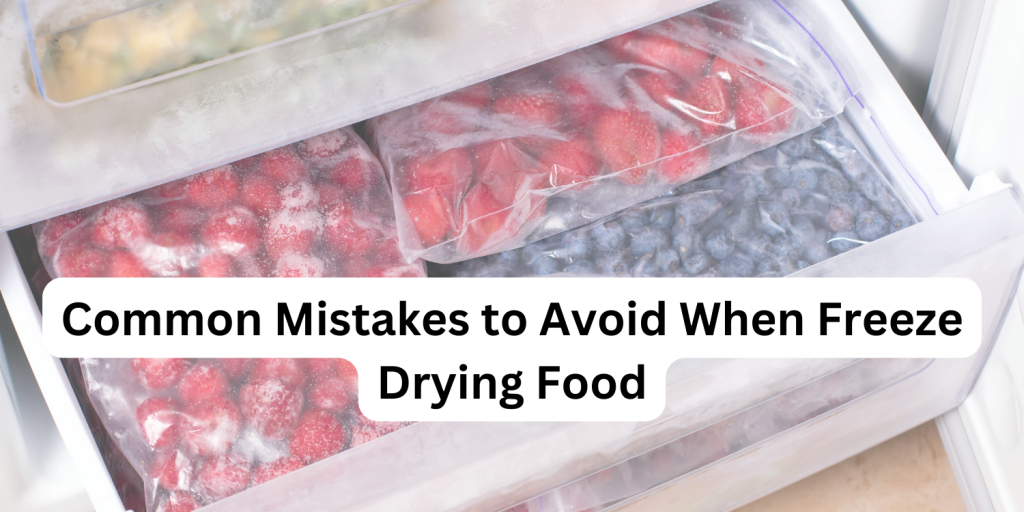Importance of Proper Technique
Freeze drying is a highly effective method for preserving food, but achieving the best results requires proper technique. Mistakes in the process can lead to poor-quality, improperly preserved food that doesn’t last as long as it should. This guide will highlight some common mistakes to avoid when freeze drying food, ensuring that your efforts result in high-quality, long-lasting products.
Overloading: Risks of Overloading the Freeze Dryer
One of the most frequent mistakes is overloading the freeze dryer. While it may be tempting to maximize the amount of food processed in one batch, overloading can lead to several issues:
- Uneven Drying: Overloaded trays can prevent proper airflow, resulting in uneven drying. Some pieces may remain partially moist, which can lead to spoilage.
- Longer Drying Times: An overloaded freeze dryer has to work harder, which can significantly extend the drying time and reduce efficiency.
- Potential Damage: Consistently overloading your freeze dryer can strain the machine, potentially leading to mechanical issues or reduced lifespan.
To avoid these problems, follow the manufacturer’s guidelines for load capacity and ensure that food is spread evenly on the trays.
Improper Pre-Freeze: Importance of Proper Pre-Freeze
Proper pre-freezing is a crucial step in the freeze drying process. Skipping or improperly executing this step can negatively impact the quality of your freeze-dried food:
- Inconsistent Results: If food isn’t thoroughly pre-frozen, the freeze dryer may not be able to remove all the moisture, leading to inconsistent results.
- Texture Issues: Foods that aren’t properly pre-frozen can have a compromised texture after freeze drying, becoming mushy or chewy instead of crisp.
- Extended Drying Time: Inadequate pre-freezing can lengthen the drying process, as the freeze dryer has to work harder to reach the correct temperature.
To ensure proper pre-freezing, spread food items in a single layer on a baking sheet and freeze them for at least 24 hours before placing them in the freeze dryer.
Incorrect Settings: Avoiding Wrong Temperature and Time Settings
Using incorrect temperature and time settings is another common mistake that can affect the quality of your freeze-dried food:
- Insufficient Drying: Setting the temperature too low or the drying time too short can leave moisture in the food, risking spoilage and reduced shelf life.
- Over-Drying: Conversely, setting the temperature too high or the drying time too long can over-dry the food, resulting in a loss of texture and flavor.
- Monitoring: Always monitor the drying process and make adjustments based on the type and quantity of food. Most modern freeze dryers come with user-friendly control panels to help manage settings.
Follow the manufacturer’s recommendations for temperature and drying time, and consider the specific requirements of different foods.
Storage Errors: Ensuring Proper Storage Post-Freeze Drying
Improper storage after freeze drying can negate all your hard work by allowing moisture to re-enter the food. Here are some common storage errors to avoid:
- Using Non-Airtight Containers: Always store freeze-dried foods in airtight containers such as vacuum-sealed bags, mason jars with tight lids, or mylar bags with desiccants.
- Ignoring Labels and Dates: Clearly label each container with the contents and the date of freeze drying. This helps you manage inventory and ensures that older items are used first.
- Exposing to Light and Heat: Store your freeze-dried foods in a cool, dark, and dry place. Exposure to light, heat, and moisture can degrade the quality of the food over time.
By taking these precautions, you can ensure that your freeze-dried foods remain fresh and ready for long-term storage.
Tips for Avoiding Common Mistakes
Freeze drying is a fantastic method for preserving food, but avoiding common mistakes is key to achieving the best results. Here are some final tips:
- Avoid Overloading: Stick to the manufacturer’s guidelines for load capacity and ensure even distribution on the trays.
- Proper Pre-Freeze: Pre-freeze foods thoroughly to ensure even drying and maintain texture.
- Correct Settings: Use the recommended temperature and drying time settings, and monitor the process closely.
- Proper Storage: Store freeze-dried foods in airtight containers in a cool, dark, and dry place, and label them clearly.



